 ‘One reason why many children do not care about history is because the great body of their own class is not represented in it at all, except sometimes as suffering from the wickedness of their elders … History is written in long paragraphs, and has scarcely an anecdote or a smart speech to brighten up its uniform solid blocks of narrative.’ These are the words of Australian author, teacher and suffragist Catherine Helen Spence. She wrote them in 1879 – a time when history books for children in the Australian colonies largely comprised stories about the kings and queens of England, with the occasional American adventure thrown in for good measure.
‘One reason why many children do not care about history is because the great body of their own class is not represented in it at all, except sometimes as suffering from the wickedness of their elders … History is written in long paragraphs, and has scarcely an anecdote or a smart speech to brighten up its uniform solid blocks of narrative.’ These are the words of Australian author, teacher and suffragist Catherine Helen Spence. She wrote them in 1879 – a time when history books for children in the Australian colonies largely comprised stories about the kings and queens of England, with the occasional American adventure thrown in for good measure.
Times have changed since Spence cast her judgement, but change came slowly.
A Sign of Things to Come – The Australia Book
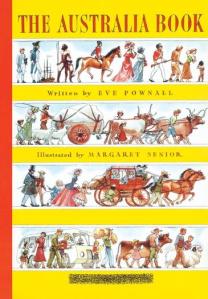
One of the earliest signs of a move away from ‘solid blocks of narrative’ was in 1952 when The House of John Sands published Eve Pownall’s The Australia Book. Here was a large-format book in which the text was conspicuously directed to a child reader and in which colour illustrations dominated. Years later, Nadia Wheatley, now a doyenne of children’s history books, would write: I have come to understand [that] The Australia Book helped to develop my sense of identity, and my sense of belonging to the land that is my home’ (Australians All, p. 280). Such was the impact – and uniqueness – of Pownall’s book that it was republished in 2008 by Black Dog Books, now an imprint of Walker Books Australia, and it is still in print.
But more years would pass before Spence’s real issue – the absence of children from historical narratives – would be addressed. As recently as 2013, novelist Thomas Keneally uncannily echoed Spence’s 1879 sentiments:
In Australian histories there is a particular group whose tales and presence and concerns are rarely narrated. These are the children and adolescents … They appear in most writing of history as mere passive accessories to what adults do.
From ‘Passive Accessories’ to Centre Stage
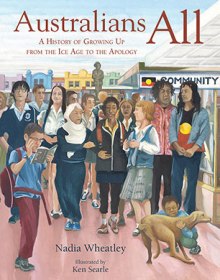
Keneally’s words appeared on the promotional blurb for Nadia Wheatley’s Australians All. Mindful of the influence of Pownall’s book in her own life, and disturbed that ‘if you turn to the back of just about any general history of Australia, and look in the index for the words “children” or “adolescents” or “young people”, you will find nothing’, Wheatley decided she would write a book in which children were front and centre. The result, Australians All, published by Allen & Unwin in 2013, went on to win the Young People’s History Prize in the 2014 NSW Premier’s History Awards; it was reprinted in 2015.
While Wheatley’s book is still a rarity in terms of its expansive view of Australia’s history, many smaller-focus history books for children have been published in the last few years; books with ‘anecdotes’ and ‘smart speech’ and in which the class of children is most definitely represented – Spence, I imagine, would be gratified.
History Books for 21st Century Australian Children – What’s Available?
Below, you will find a selection of books, both fiction and non-fiction, published between 2013 and 2016. Many feature a child or a young person as protagonist. The books, with brief descriptions, are divided into three categories: ‘Big Picture’ Histories are listed first, followed by ‘Eras and Events’, and ‘People, Organisations and Animals’. Book series, which fit into the second and third categories, are grouped together at the head of those two categories. The list is not exhaustive; you can find tips for discovering more books under the Links and Sources heading. Please note that age ranges should be used as a guide only.
‘Big Picture’ Histories
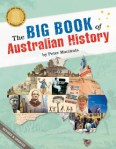
Peter Macinnis. The Big Book of Australian History. First published in 2013. Second edition: Canberra: NLA Publishing, 2015, 292pp. (New edition due in April 2017.) (Non-fiction) Ages 10+
Largely chronological, this book begins with chapters on ‘Ancient Australia’ and ‘The Dreaming’. Further chapters trace European discovery and colonisation, economic development and wars. Some major themes (e.g. natural disasters, sport and multiculturalism) are explored before a closing section titled ‘You Are a History Maker’ in which Macinnis asks readers to remember: ‘What you do in your life becomes part of Australia’s history’ (278).
Richly illustrated with images of items held in the National Library of Australia’s collection; good design, including breakout text boxes, makes it easy to dip in and out of this book.
Nadia Wheatley and Ken Searle (illus.). Australians All: A History of Growing Up, from the Ice Age to the Apology. First published in 2013. Reprinted: Crows Nest, NSW: Allen & Unwin, 2015, 280pp. (Non-fiction) Ages 10+
Tells ‘the real-life stories’ of about 80 young Australians and their families. The stories unfold chronologically, beginning with Ice Age and moving through to the 2008 Apology to the Stolen Generation, and are woven into a wider telling of the era in which each child lived. A final section titled ‘What happened to the children and families’ gives further factual sources for each child’s story.
Detailed teachers’ notes are available via the Allen & Unwin website. (Although the site says the book is currently out of print (as of November 2016), it is still available in bookstores and from some online booksellers.)
Book Series

Our Australian Girl. Melbourne: Penguin, 2014-2016, approx. 100pp. (Some titles available in omnibus editions.) (Fiction) Ages 8+
Eras and events: colonial era (Grace, Poppy, Letty, Nellie), Federation (Rose), Great Depression (Ruby, Daisy), World War I (Alice), World War II (Pearlie), post-World War II (Lina) and Indo-Chinese boat people (Marly).
Each title character features in four books; characters include a mix of ethnicities (e.g. Poppy is of Indigenous and Chinese heritage, Lina is Italian, and Marly is Vietnamese). The Our Australian Girl website provides a range of information including background on the characters, extracts, quizzes, and notes for parents and teachers.
Do You Dare? Melbourne: Penguin, 2014-2015, approx. 200pp. (Fiction) Ages 8+
Eras and events: convict era (Fighting Bones), colonial era (The Bushranger’s Boys, The Last Horse Race, Eureka Boys), World War I (Jimmy’s War) and the Great Depression (Tough Times).
Adventure series marketed for boys.
Our Stories. Newtown, NSW: Black Dog Books, 2013-2016, approx. 32pp. (Non-fiction) Ages 7+
Eras and events: convict era, (Child Convicts), colonial era (Life in Colonial Australia, Life on the Goldfields, Eureka Stockade) and Federation (Australian Federation). Also, sport (Sportsmanship), protest movements (Protest in Australia), literature (Australian Writers of Influence), flags (Australian Flags and Emblems) and Canberra (Canberra: Federal Capital).
People: Mary MacKillop (Mary’s Australia), Prime Ministers (So You Want To Be Prime Minister?), military personnel (For Valour: Australia’s Victoria Cross Heroes) and inventors (Great Aussie Inventions).
Text is presented in short information bites.
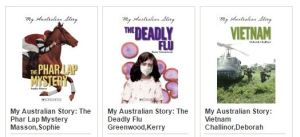
My Australian Story. Lindfield, NSW: Scholastic Australia, 2014, 200+pp. (Fiction and non-fiction) Ages 9+
Eras and events: convict era (Rum Rebellion), colonial era (bushrangers, blackbirding, gold rushes, reformatory schools for girls, Eureka Rebellion), World War I (including Gallipoli), 1919 influenza epidemic, World War II (including Kokoda, the bombing of Darwin, Tobruk), Vietnam War, Maralinga, Stolen Generations, 1938 ‘Black Sunday’ on Bondi Beach, Vietnam War moratoriums, Federation, the Sydney Harbour Bridge opening, Snowy Hydro-Electric Scheme construction, White Australia Policy, Cyclone Tracy and Refugees .
People, organisations and animals: Phar Lap (race horse), Don Bradman, Royal Flying Doctor Service and Archer (race horse).
Our Past. Clifton Hill, Vic.: Wild Dog Books, 2015, 24 pp. (Non-fiction) Ages 7+
Eras and events: European exploration, convict era and the colonial era (gold, bushrangers).
Short, basic introductions; large format.
Australia’s Great War. Lindfield, NSW: Scholastic Australia, 2014- , approx. 200pp. (Fiction) Ages 9+
Eras and events: a year-by-year snapshot of major events from World War I. Each title in the series is published a century after the events took place (e.g. Sophie Masson’s 1914 was published in 2014; Kelly Gardiner’s 1917 will be released in early 2017.)
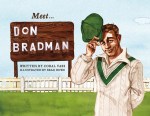
Meet… Sydney: Penguin Random House, 2013-2016, 32pp. (Non-fiction) Ages 6+
People and organisations: Ned Kelly, Mary MacKillop, Captain Cook, The ANZACs, Douglas Mawson, Nancy-Bird Walton, Banjo Paterson, Weary Dunlop, Sidney Nolan, Don Bradman, Nellie Melba, The Flying Doctors.
Australian First Settlement. Kew East, Vic.: Berbay Publishing, 2013-2017, approx. 32pp. (Non-fiction) Ages 8+
People: The Unlikely Story of Bennelong and Phillip, William Bligh: A Stormy Story of Tempestuous Times, Lachlan Macquarie (coming in 2017).
Narratives addressed directly to the reader.
Eras and Events
Convict era:
Simon Barnard. A – Z of Convicts in Van Diemen’s Land. Melbourne: Text, 2014, 86pp. (Non-fiction) Ages 10+
Beautifully produced and richly detailed account of the lives of convicts in Van Diemen’s Land (Tasmania). Includes a glossary, index and bibliography. Colour illustrations include cutaways and other perspectives on a range of buildings and boats. A large book (41 x 29cm); excellent for poring over detailed text and images.

Claire Saxby and Elizabeth Newcomb. My Name Is Lizzie Flynn. Newtown, NSW: Walker Books Australia, 2015, 32pp. (Fiction) Ages 7+
Fictionalised account, told through one young person’s eyes, of the creation by female convicts of the Rajah quilt.
Mark Wilson. Beth: The Story of a Child Convict. Sydney, NSW: Hachette Australia, 2016, 32pp. (Fiction) Ages 7+
Told in the first person through a child’s eyes; recounts the journey to Sydney Cove with the First Fleet and the early months of life in the colony. (Fictional entries from the diary of the colony’s surgeon provide additional detail.)
Colonial era:
James Moloney. Bridget. Parkside, SA: Omnibus Books, 2015, 247pp. (Fiction) Ages 8+
Migration to Australia, prompted by the Irish potato famine and the hardships of the workhouse.
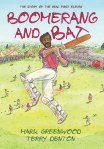
Mark Greenwood and Terry Denton. Boomerang and Bat: The Story of the Real First Eleven. Crows Nest, NSW: Allen & Unwin, 2016, 32pp. (Non-fiction) Ages 7+
The 1868 tour to England of a team of Aboriginal cricketers led by all-rounder Unaarrimin, also known as Johnny Mullagh.
World War I:
Patrick Carlyon. The Gallipoli Story. Crows Nest, NSW: Allen & Unwin, 2015 (rev. ed.), 204pp. (Non-fiction) Ages 11+
Deals with some myths surrounding events at Gallipoli and focuses on the choices made by soldiers and politicians. Includes maps, index, detailed end notes and photographs.

Morris Gleitzman. Loyal Creatures. Melbourne: Penguin, 2014, 161pp. (Fiction) Ages 9+
A window into the world of the Australian Light Horse through the life of one 16-year-old volunteer and his horse.
Mark Greenwood. Midnight. Newtown, NSW: Walker Books, 2015, 32pp. (Non-fiction) Ages 5+
The Australian Light Horse charge at Beersheba told from the perspective of Lieutenant Guy Haydon and his mare, Midnight.
Federation:
Net Brennan. Australian Federation: One People, One Destiny. Newtown, NSW: Walker Books Australia, 2014, 48pp. (Non-fiction) Ages 8+
The framing of the constitution by ‘ordinary citizens’. Large format, plenty of illustrations, timeline, references.
Maralinga:
Christobel Mattingley. Maralinga’s Long Shadow: Yvonne’s Story. Crows Nest, NSW: Allen & Unwin, 2016, 196pp. (Non-fiction) Ages 12+
The effects of the 1950s nuclear tests on Anangu woman Yvonne Edwards and her family.
Anzac Day:
Rebecka Sharpe Shelberg and Robin Cowcher. Reflection: Remembering Those Who Serve in War. Newtown, NSW: Walker Books Australia, 2016, 22pp. (Non-fiction) Ages 6+
Delicate illustrations match Anzac Day observances in Australia with images of war settings. Includes a final double page spread on ten different conflicts in which Australians have been involved.

Christobel Mattingley and David Kennett. Forward March. Parkside, SA: Omnibus Books, 2016, 32pp. (Non-fiction) Ages 6+
A reflection on Anzac Day. Heavily illustrations with a mixture of drawings and photographs.
Transport:
Jane Jolly and Robert Ingpen. Tea and Sugar Christmas. Canberra: NLA Publishing, 2014, 36pp. (Non-fiction) Ages 5+
A supply train travelled weekly across the Nullarbor Plain for most of the 20th century – it made a special delivery at Christmas time. Fold out, double page illustrations.
People, Organisations and Animals
Paul Stafford. Captain Flinders’ Map. Chatswood, NSW: New Holland Publishers, 2016, 256pp. (Fiction) Ages 9+
Matthew Flinders’ circumnavigation of the Australian continent.
Mark Greenwood and Terry Denton. Jandamarra. Crows Nest, N.S.W.: Allen & Unwin, 2013, 45pp. (Non-fiction) Ages 7+
The story of Indigenous warrior Jandamarra of the Bunuba people of the Kimberley region, from his childhood to his violent death.
Corrine Fenton and Andrew McLean. Bob the Railway Dog. Newtown, NSW: Black Dog Books, 2015, 32pp. (Non-fiction) Ages 5+
The tale of the railway dog that rode the trains in South Australia during the rail-building era of the 1880s.

Peter Gouldthorpe. Ice, Wind, Rock: Douglas Mawson in the Antarctic. Sydney: Lothian Children’s Books, 2013, 32pp. (Non-fiction) Ages 8+
An account of Douglas Mawson’s Antarctic explorations.
Stephanie Owen Reeder. Lennie the Legend: Solo to Sydney by Pony. Canberra: NLA Publishing, 2015, 107pp. (Creative non-fiction) Ages 8+
The story of nine-year-old Lennie Gwyther who rode his pony from Gippsland to Sydney to witness the opening of the Sydney Harbour Bridge. Includes glossary, index, further reading. Illustrated with photographs, postcards, maps and other memorabilia from the time of Lennie’s ride.
Jane Jolly and Robert Ingpen. Radio Rescue! Canberra: NLA Publishing, 2016, 34pp. (Fiction) Ages 6+
The connections afforded to people in outback through the provision of radio transmitters and the inauguration of the Royal Flying Doctor Service.
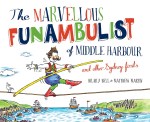
Hilary Bell and Matthew Martin. The Marvellous Funambulist of Middle Harbour and Other Sydney Firsts. Sydney: NewSouth Publishing, 2015, 47pp. (Non-fiction) Ages 6+
A quirky list of Sydney ‘firsts’ including the first mother-and-daughter taxidermist business, the first crossing of Middle Harbour by a tight-rope walker, and the first concert at the Opera House (while still a construction site) given by Paul Robeson. Written in verse form with much humour.
Looking for More?
For more Australian history written for Australian children, see also my 2020 blog post, ‘More Australian History for Australian Kids … This Time from an Indigenous Perspective’.
Links and Sources:
- Catherine Helen Spence: ‘Gossip about Children’s Books, South Australian Register 5 December 1879: 5.
- Macmillan Education publishes a range of Australian history book series suitable for primary school-aged children. These include Macmillan’s Stories from Australia’s History, Macmillan History, The Gold Rushes and Colonial People.
- The following links will lead you to more Australian history books written for children: the Children’s Book Council of Australia’s (CBCA’s) Eve Pownall Award often features books on Australian history (search the Council’s website for ‘Eve Pownall’ to see all honour books and winners of the award); see also the ‘Information Books’ reviews in the CBCA’s online Reading Time journal and the NSW Premier’s History Awards, Young People’s History Prize.
You can search library catalogues (e.g. Trove Australia) for lists of books. Use subject searches like: Australia — History — Juvenile fiction, or Australia — History — Juvenile literature. (Narrow your search to list only ‘Australian content’ and only ‘book’ format.) - For online Australian history resources, see My Place.

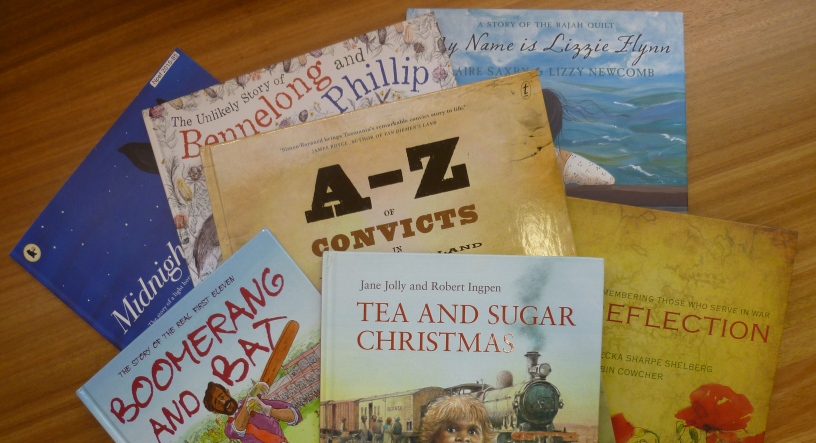





Leave a comment